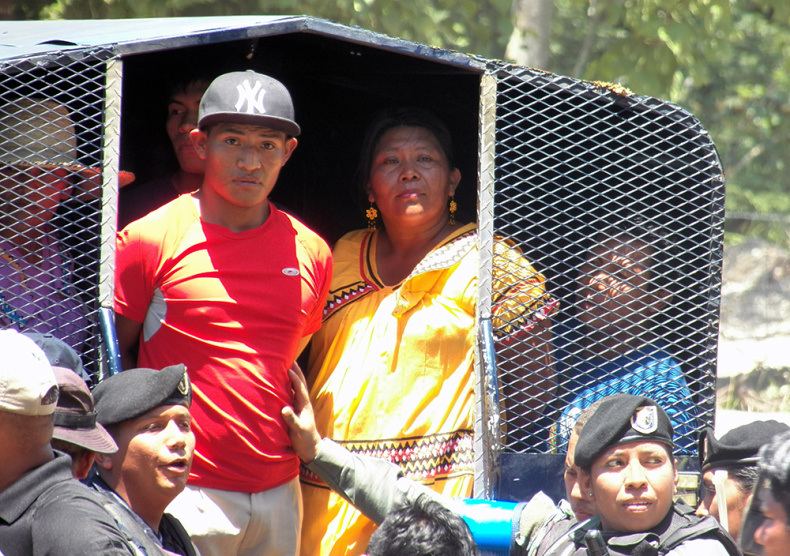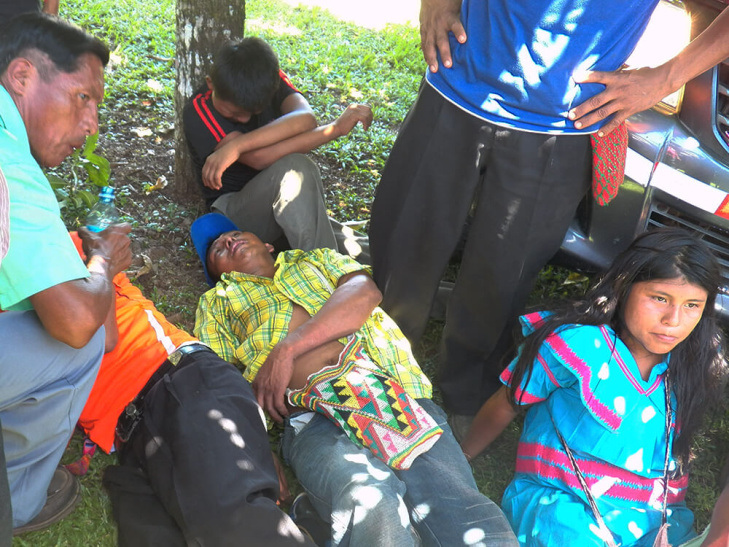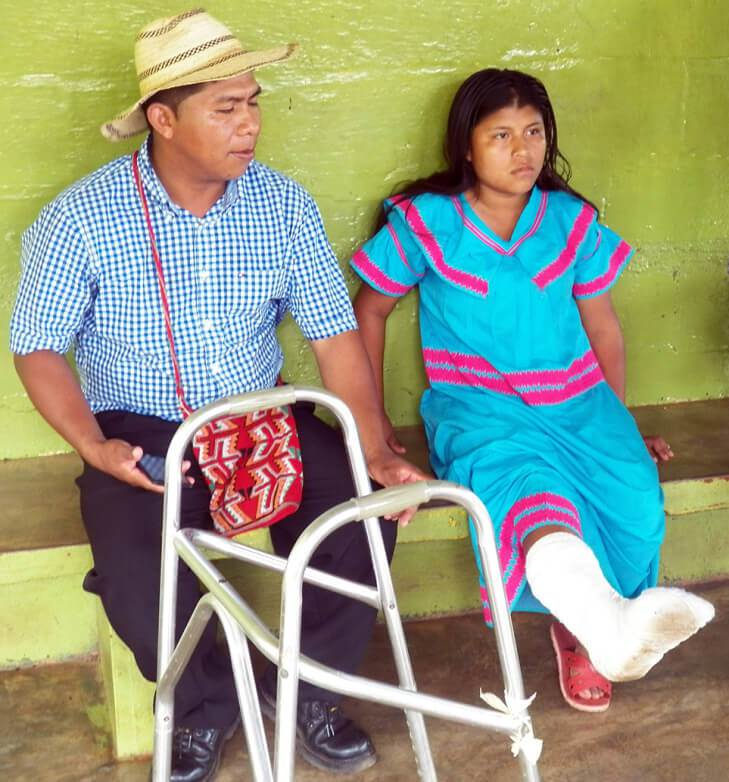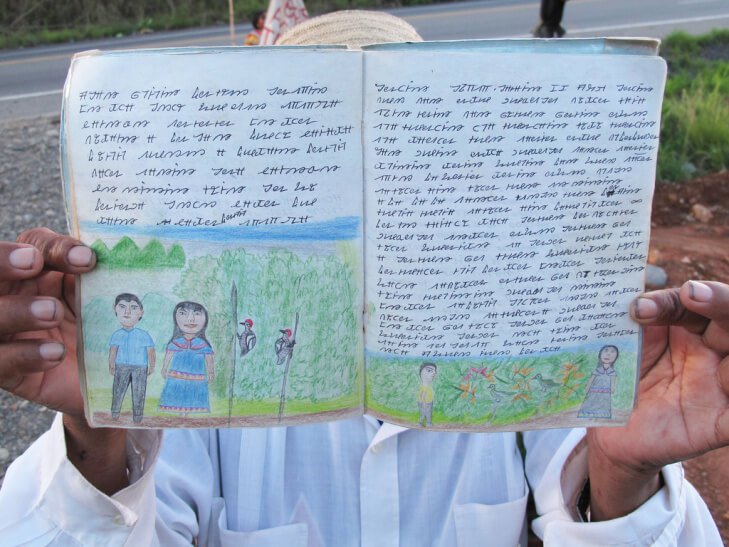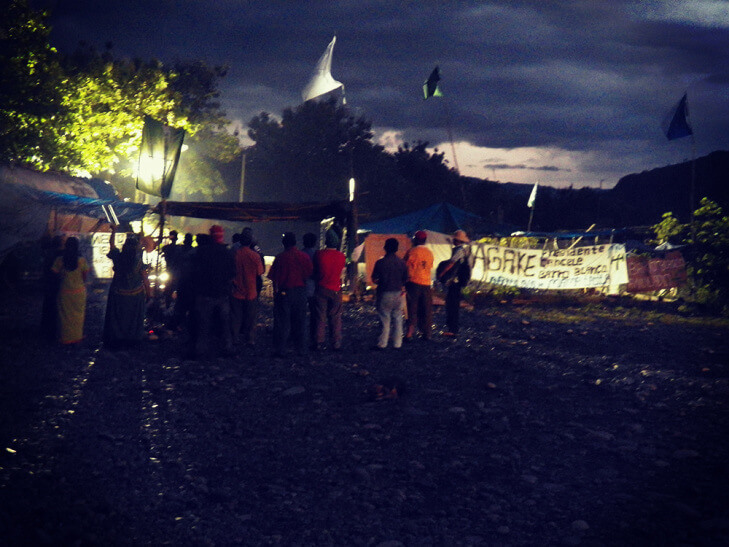
by DGR Colorado Plateau | Aug 29, 2015 | Indigenous Autonomy, Mining & Drilling, Protests & Symbolic Acts
August 29, 2015
This morning, activists marched across The Bridge of the Gods to protest a proposed Nestlé bottled-water plant at Cascade Locks, Oregon.
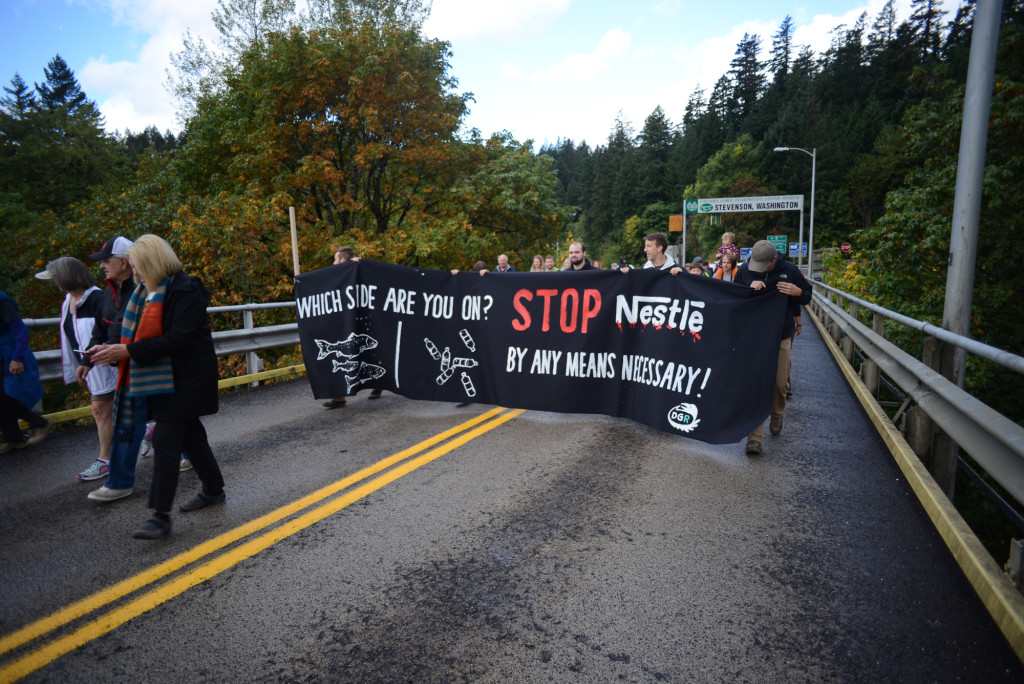
The bridge is only opened once a year for pedestrian traffic. Hundreds of sightseers and community members gather for the stunning view of the Columbia River. Today, they were joined by twenty protesters, who marched with a bridge-spanning banner that read: “Stop Nestlé By Any Means Necessary.”
Nestlé is the world’s largest food and beverage firm. Despite a history of human rights abuses, this Switzerland-based corporation has made billions privatizing public water supplies around the world.
Their planned bottling facility in the Columbia River Gorge would siphon off 118 million gallons of water every year from Oxbow Springs. Opposition is widespread, especially from indigenous communities.
“Nestlé already has millions, they don’t need our water,” said Ernest J. Edwards of the Yakama Nation. “Our water is for the salmon.”
Treaties made with the Confederated Tribes of Warm Springs recognize their fishing rights. Tribal member Anna Mae Leonard held a five-day hunger strike last week, surviving only on water from Oxbow Springs. Despite this community opposition, the State of Oregon and local governments have so far sided with Nestlé.
“The water of the Gorge does not belong to Nestlé. It belongs to the Salmon, to the forests, to all non-humans, and to the indigenous communities,” said protester Jules Freeman. “It’s a desecration to bottle this water in toxic plastic and sell it back to us for a profit.” Freeman is a member of Deep Green Resistance, the group that organized the protest.
Opposition to Nestlé bottled water plants has been successful in the past; projects in Florida, Wisconsin, California, and elsewhere were scrapped after communities rose up in defiance. Freeman thinks the same can be done here.
“The community does not want this, but the government has not listened. But it doesn’t matter: if they won’t stop Nestlé, we will.”
If you are concerned about the Nestlé project, contact Oregon Governor Kate Brown at 503-378-4582 and Oregon Department of Fish and Wildlife Director Curt Melcher at 503-947-6044.

by DGR Colorado Plateau | Aug 28, 2015 | Indigenous Autonomy, Lobbying
By Dan Bacher / Intercontinental Cry
A federal judge on Aug. 26 denied a request by the San Luis Delta Mendota Water Authority and Westlands Water District for a temporary restraining order and preliminary injunction against the higher supplemental flows from Trinity Reservoir being released to stop a fish kill on the lower Klamath River.
The releases that the U.S. Bureau of Reclamation began last week, resulting from requests by the Hoopa Valley and Yurok Tribe fishery scientists to release Trinity River water to stop a fish kill–like that one that killed up to 78,000 adult salmon in September 2002–will continue. The two Tribes, the Pacific Coast Federation of Fisherman’s Associations and the Institute for Fisheries Resources were intervenors for the defendant, Interior Secretary Sally Jewell and the U.S. Department of Interior, in the litigation.

Trinity River below the Lewiston Dam during last year’s supplemental water releases (Photo: Dan Bacher)
In his decision, U.S. District Court Judge Lawrence O’Neill said,
The Court concludes that there is no clear showing of likelihood of success on the merits. Even if Plaintiffs are likely to succeed on the merits of at least one of their claims against Reclamation in connection with the 2015 FARs (Flow Augmentation Releases), the balance of the harms does not warrant an injunction at this time.
“The potential harm to the Plaintiffs from the potential, but far from certain, loss of added water supply in 2015 or 2016 does not outweigh the potentially catastrophic damage that ‘more likely than not’ will occur to this year’s salmon runs in the absence of the 2015 FARs,” ruled O’Neill.
This denial of the request by corporate agribusiness interests to halt badly needed flows for the lower Klamath River is a big victory for the Hoopa Valley Tribe, Yurok Tribe and fishing groups. Both this year and last, Tribal activists held protests demanding the release of Trinity River to stop a fish kill.
Read more at Intercontinental Cry
by DGR Colorado Plateau | Aug 22, 2015 | Colonialism & Conquest, Indigenous Autonomy, Lobbying
Editor’s Note: An original, unabridged version of this article is available at Coal Stop. You can read more and sign up for updates on the proposed Gateway Pacific Terminal at their website.
By Sandy Robson / Intercontinental Cry
United States Senator Steve Daines (R-MT) is on a mission to do whatever it takes to get the Gateway Pacific Terminal (GPT), a 48 million metric-ton-per-year coal export terminal, permitted and built. The GPT project is proposed in Whatcom County, Washington, and would be sited at Xwe’chi’eXen (Cherry Point), along the shoreline, which is part of the Lummi Nation’s traditional fishing area. The company proposing GPT is Pacific International Terminals (PIT), a subsidiary created for the project by SSA Marine.
Tens of thousands of people who steadfastly oppose GPT are standing in the way of Senator Daines, SSA/PIT, and the coal companies like Cloud Peak Energy which have financial interests in seeing that GPT is built and operating. Also standing in the way is the Lummi Indian Tribe, a sovereign nation, standing tall in defense of its treaty rights.
On July 29, Senator Daines’ official website featured a press release about the senator and Congressman Ryan Zinke (R-MT), having led a group of sixteen senators and seventeen members of the House in sending two July 28, 2015 letters (one from the Senate and one from the House) to the U.S. Army Corps of Engineers. The letters urged U.S. Assistant Secretary of the Army Jo-Ellen Darcy, to complete the environmental review process for the proposed GPT project prior to the Corps making a determination whether impacts to any tribes’ U&A (usual and accustomed) treaty fishing rights are more than de minimis, or too trivial to warrant legal review.’
An August 3, 2015 Lummi Nation press release announced that Lummi Indian Business Council (LIBC) Chairman Tim Ballew II sent an August 3 letter to Senator Daines, cc’d to the thirty-two legislators who signed onto those letters, and the Senate Committee on Indian Affairs. In his letter, Ballew reminded them of the U.S. government’s obligation to protect and preserve the Lummi Nation’s treaty fishing rights.
BACKGROUND LEADING UP TO DAINES’ RECENT ACTIONS
In determining whether Lummi Nation’s treaty-guaranteed rights of access to its U&A fishing grounds and stations, and harvest of fish, would be adversely impacted by GPT, the Corps will be applying a de minimis threshold standard. Any impacts considered to be greater than de minimis by the Corps would warrant the GPT permit denial requested by the Lummi Nation.
The fact that the Corps “owes the highest fiduciary duty to protect Indian contract rights as embodied by treaties” is entrenched in case law. That solemn duty and obligation owed to the Lummi Nation by the U.S. federal government is something the agency takes extremely seriously, and addresses separately from any Environmental Impact Statement (EIS) the Corps is tasked with on proposed projects.
Treaty fishing rights of the Lummi are secured to them by the U.S. federal government in the Treaty of Point Elliott of 1855. Article 5 of the Treaty provides that, “The right of taking fish from usual and accustomed grounds and stations is further secured to said Indians in common with all citizens of the Territory. . .”
XWE’CHI’EXEN: WHAT IT MEANS TO THE LUMMI
Lummi Nation’s Sovereignty and Treaty Protection Office Director Jewell James provided some important insight on the significance of Xwe’chi’eXen (Cherry Point) to the Lummi, in the August 2013 issue of Whatcom Watch:
The Lummi have usual and accustomed fishing grounds scattered throughout the San Juan Islands and on the mainland of Whatcom County up to the Canadian border. Not only were our (fishing) village sites located throughout the territory, but the associated burial grounds are located at these sites, as well. Among the most important of these cultural landscapes is Xwe’chi’eXen (Cherry Point).
LIBC Chairman Tim Ballew sent a January 5, 2015 letter to the Army Corps of Engineers, asking the Corps to take action and immediately deny SSA/PIT’s permit application for the proposed GPT project. Ballew wrote:
Review of the impacts associated with this project, including, but not limited to, those analyzed in the Gateway Pacific Terminal Vessell [sic] Traffic and Risk Assessment Study lead to the inescapable conclusion that the proposed project will directly result in a substantial impairment of the treaty rights of the Lummi Nation throughout the Nation’s ‘usual and accustomed’ fishing areas. The Lummi have harvested at this location since time immemorial and plan to continue into the future.
SENATOR ATTEMPTS TO BLOCK ARMY CORPS’ DECISION-MAKING PROCESS
It’s also not surprising that the legislators who signed onto the July 28 letters to the Army Corps, altogether, received over $400,000 in contributions in 2014, from the same GPT-related interests listed above. It’s no surprise that Senator Daines is willing to be Montana coal industry’s point person on the proposed GPT project, because according to opensecrets.org, in 2014, Daines received over $50,000 in total campaign donations from the following contributors connected to the GPT project: Cloud Peak Energy, SSA Marine, FRS Capital Corp. (ultimate parent company of SSA Marine), Peabody Energy, BNSF, Boich Companies (part owner of Global Coal Sales Group, and the National Mining Association (an active advocate for the coal industry).
According to the August 3 Lummi Nation press release previously mentioned in this article, it turns out that the two July 28 letters sent to the Corps by the thirty-two legislators came after three failed attempts by Senator Daines to attach a specifically crafted amendment to various pieces of unrelated legislation. The amendments were designed to try to prohibit the Army Corps from making its determination regarding the Lummi Nation’s treaty fishing rights relating to GPT, before the final EIS would be completed for the project.

Excerpt of Senate Amendment (S.A.) 1809, proposed by Senator Daines on June 8, 2015
One of those amendments, Senate Amendment (S.A.) 1809, was proposed by Senator Daines on June 8. It was an amendment to Senator John McCain’s (R-AZ) Senate Amendment (SA 1463) attached to a piece of unrelated legislation, the National Defense Authorization Act (H.R. 1735) for fiscal year 2016.
Another example of Senator Daines’ attack on Lummi treaty rights was cited in LIBC Chairman Tim Ballew’s August 3 letter to the senator. His letter included a copy of the language that Daines apparently tried to insert as a proposed amendment to yet another piece of unrelated legislation (H.R. 22). The amendment text was the same language that was proposed in S.A. 1809.An excerpt from S.A. 1809 reads, “The Corps of Engineers shall not make any determination regarding usual and accustomed fishing places in connection with the Gateway Pacific Terminal project until after the Corps issues a final environmental impact statement. . .” S.A. 1809 never received debate as it was withdrawn, so it did not move forward to a vote.
Chairman Ballew admonished Senator Daines in the August 3 Lummi Nation press release:
Senator Daines has repeatedly sought to interfere in the Army Corps’ regulatory review process by seeking to attach legislative amendments to various bills moving through Congress. It’s unconscionable that, as a member of the Senate Indian Affairs Committee, he chooses to ignore treaty rights. He has repeatedly tried to diminish the rights of the Lummi Nation using “middle-of-the-night” stealth legislative tactics that have prevented stakeholders from weighing in.
BURYING AMENDMENTS IN UNRELATED LEGISLATION TO BURY TREATY RIGHTS
Amendments are often attached to unrelated bills, but riders that undermine treaties and sacred sites are particularly egregious. In December 2014, Senator McCain successfully buried an amendment he attached to the 1600-page 2015 National Defense Authorization Act (H.R. 4435). The must-pass NDAA legislation that Congress moves yearly was used as a vehicle by McCain to pass a morally suspect public lands exchange package involving land at Oak Flat, in Eastern Arizona.
Senator McCain’s “midnight” rider which disregards and diminishes treaty rights of the San Carlos Apache and other nearby tribes that he managed to sneak through in 2014, and the repeated legislative attempts by Senator Daines to trample Lummi treaty rights, illustrate the serious harm that can befall the Lummi Nation every single day that passes before the Army Corps makes its determination.
SSA Marine’s vice president Skip Sahlin, sent a May 12, 2015 letter to the Army Corps asking for an extension to respond to the Lummi Nation’s request to the Corps for an immediate denial of the GPT permit application because the terminal would interfere and impinge on the Nation’s treaty-protected fishing rights. In that letter, Sahlin claimed that allowing SSA/PIT the requested additional time “will not harm the Tribe or its treaty rights. . .”
The treaty rights of the Lummi Nation are under attack, and their Nation has had to expend untold efforts to defend those rights secured to them in 1855 by the United States. Every day that passes as the Army Corps is making its decision on the fate of the GPT permit, is another opportunity for coal-backed legislators such as Senator Daines to craft legislation aimed at weakening Lummi Nation’s treaty rights. Reasonable persons would conclude that despite Mr. Sahlin’s claim to the contrary, harm has been done to the Lummi Nation each day that has passed since February 2011, when SSA/PIT first submitted the application for its proposed GPT project to Whatcom County’s planning department.
Chairman Ballew made it clear in his letter to Senator Daines that the Lummi Nation will fight resolutely to defend and protect its treaty rights: “I can assure you, that if the Lummi Nation’s Treaty Fishing Rights are jeopardized by any efforts to allow the project to proceed, we will fight vigorously by all means necessary. In times past, our Nation and its leaders did not have the resources and were unable to stop prior efforts to construct commercial terminals in our region. That day is no more.”
From Intercontinental Cry
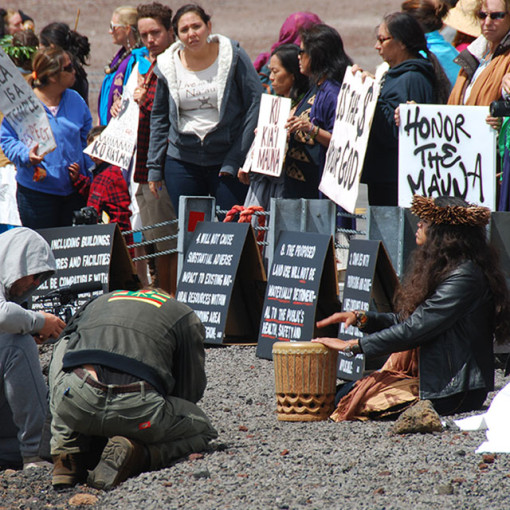
by DGR Colorado Plateau | Aug 21, 2015 | Colonialism & Conquest, Strategy & Analysis, White Supremacy
Editor’s Note: For further analysis of effective resistance movements, please visit the Deep Green Resistance Book, and read about our strategy: Decisive Ecological Warfare.
By Will Falk / Deep Green Resistance
When I am in Hawai’i, I ask everyone I meet if the United States will ever voluntarily de-occupy the Islands. No one ever says yes. Usually, before I can say anything else, people hurriedly start talking about the lack of a valid treaty or that the American occupation is illegal by their own laws or that the United States will pay for its human rights violations.
I am a haole in Hawai’i, a white settler in the United States. I acknowledge that every square inch of the United States of America exists on stolen native land. Leadership in land based struggles in the United States rests most properly in the hands of indigenous peoples. I will not undermine indigenous leadership, so I direct my thoughts to other settlers.
If no one believes that the United Sates will ever voluntarily de-occupy Hawai’i, why are so many of the movement’s settler supporters so focused on achieving this impossible voluntary withdrawal? Why, for example, do so many settlers spend so much energy supporting a parade in Oahu – a parade that is billed as a march for Hawaiian sovereignty while quietly being a voting drive to encourage participation in the occupying American government? Why do so many settlers hold up expensive court cases relying on American judges who are paid by the American government to make decisions leading to this mythical voluntary de-occupation as the only viable means for de-occupation?
The first answer is privilege. Settlers benefit from the current arrangement of power in Hawai’i. These Islands represent the tourist fantasy to many settlers despite the fact that Hawai’i’s life support systems are inches away from total collapse. The inability of settler support to recognize that Hawaiian de-occupation is our responsibility leads me to conclude that most settlers are not as concerned with Hawaiian liberation as they are concerned with maintaining a feel-good environment that balances settler crises of conscience while never threatening settler access to Hawai’i. Hawai’i does not have time to coax these settlers from their positions of privilege. So, I direct my thoughts to settlers of strong heart who simply suffer from a lack of analysis.
Apart from privilege, the second reason settlers have proven unable to mount a serious solidarity effort with the Hawaiian de-occupation movement is they see no alternative to a liberal mindset. “Wait a minute,” I hear a lot of confused readers saying, “Aren’t liberals good?” No, actually. It’s too late to rely exclusively on liberalism. Hawai’i has been cursed for 122 years of occupation with too much liberalism. Liberalism is the haoles’ game. Liberalism serves the United States of America. Liberalism renders resistance ineffective and must be forsaken if de-occupation is to be achieved.
The alternative is radicalism. An examination of the differences between the liberal and radical world views will demonstrate how radicalism arms settlers seeking to demonstrate true solidarity with a better analysis for forming an effective de-occupation strategy. This is not to say that a mixture of tactics cannot be effective. The Hawaiian de-occupation movement should not remove any tool from the table, but the longer Hawai’i remains occupied the clearer it becomes that decisive action is needed.
***
Before I begin, I would like to absolve the term “radical” of the bad reputation it has received in popular circles. Too many people confuse the word “radical” with the word “extreme.” But, as the great African-American activist Angela Davis has explained and as every major dictionary will tell you, the word radical simply means “getting to the root” and is most properly applied to political analyses that seek the origins of oppression.
The brilliant writer and activist Lierre Keith has pointed out two fundamental differences between liberals and radicals. The first difference revolves around individualism. Liberals believe that the basic social unit is the individual, while radicals believe the basic social unit is group or class. This reliance on individualism allows liberals to claim that every individual is entitled to their personal identity free from the realities accompanying social class. In fact, for many liberals, it is an insult to be identified with a certain group regardless of political reality.
For radicals, on the other hand, each individual is socially constructed by political reality. Radicals embrace their social group recognizing it as a source of strength. The first step to affecting change is making common cause with those who share your condition.
The other big difference between liberals and radicals is a disagreement on the nature of social reality. Liberals subscribe to a certain idealism while radicals root their analysis in materialism. For liberals, thoughts, mental states, and attitudes are the only sources and, therefore, solutions for oppression. Liberals locate reality in the human mind and tend to think that education is always the key to social change. For liberals, evil is a misunderstanding and if oppressors can just be shown the error of their ways, they will change.
How does this play out in Hawai’i? Take the role of white supremacism in the domination of Hawai’i, for example. Liberals, long ago, succumbed to the lie that racism and white supremacism are merely emotional states held in the hearts of individuals. They confine the definition of racism to hatred based on the color of one’s skin and confine the definition of white supremacism to hatred for everyone who is not white.
It is astronomers relying on a liberal definition of racism who can claim they are not racist because they hold no hatred in their hearts for the Hawaiian people while still insisting on destroying Mauna Kea’s summit to build telescopes. It is mining executives relying on a liberal definition of white supremacism who can claim no hatred in their hearts for native peoples while insisting that the guts be ripped from native land and poisons pumped into native waters to provide iron ore for the telescopes that destroy native peoples’ sacred sites.
Radicals see tangible systems of power maintained through force and working in the real, physical world as the sources and solutions of oppression. Education is an important first step to building radical consciousness, but they see organized political resistance and force as the means by which real change is achieved. Evil is not a misunderstanding. It is intentional and gives material benefits to oppressors. Oppression is always linked to resource extraction.
An emotional state – like hatred – might contribute to white supremacism, but radicals are less concerned with changing the hearts and minds of those murdering people of color and murdering the world, and more concerned with stopping the destruction. Hawaiian radicals, like Haunani-Kay Trask, for example, see racism as, “A historically created system of power in which one racial/ethnic group dominates another racial/ethnic group for the benefit of the dominating group.” White supremacism is the latest version of this system of power with white people dominating everyone else.
Racism and white supremacism establish, “Economic and cultural domination as well as political power…in the systemic dominance of the exploiting group.” Finally, radicals recognize, as Trask pointed out, that the dominating group holds a monopoly on the means on violence. It is this violence that must be confronted and dismantled if racism and white supremacism are ever truly going to be undermined.
To take this even further, consider what would happen if the liberal analysis was carried out to it’s logical conclusion. Imagine that liberals were actually successful at convincing those in power to treat every one in the world with love and kindness. Without a corresponding change in material reality, there would still be a huge problem. The dominant culture is built on the exploitation of natural resources. Resources are becoming scarcer and scarcer. Humans need to eat, for example, but topsoil is so depleted that major crops are all supported by oil. What will happen, despite the liberal conversion to loving kindness, when the dominant culture needs oil and indigenous peoples and others refuse to give up their lands to give them that oil?
***
A primary strength of the radical analysis is its ability to articulate the role power plays in oppression. Gene Sharp, the world’s foremost authority on civil disobedience and direct action tactics, has identified two manifestations of power – social and political. Social power, for Sharp, is “the totality of all influences and pressures which can be used and applied to groups of people, either to attempt to control the behavior of others directly or indirectly.” Political power is “the total authority, influence, pressure, and coercion which may be applied to achieve or prevent the implementation of the wishes of the power-holder.”
The powerful do everything they can to convince the oppressed that the current arrangement of power is inevitable. To believe power is inevitable is a mistake. Sharp says, “Power, in reality, is fragile, always dependent for its strength and existence upon a replenishment of its sources by the cooperation of a multitude of institutions and people – cooperation which may or may not continue.” The key to Hawaiian de-occupation, then, is dismantling American power. Power is dismantled most effectively by cutting it off at its sources.
Sharp lists six sources of power: authority, human resources, skills and knowledge, intangible factors, material resources, and sanctions. Jacques Maritain defines authority as “the right to command and direct, to be heard or obeyed by others” and Sharp notes that it is enough that those in power be perceived and accepted as superior. Human resources are simply defined as the number of people who obey those in power and will do their bidding. Those in power derive power from the skills, knowledge, and abilities of those who will do their bidding. Closely tied to skills and knowledge, intangible psychological and ideological factors like cultural history and spirituality can be leveraged by those in power to dominate others. Those in power need material resources like property, money, and sources of energy to maintain their power. Finally, those in power must have means to enforce obedience – punishment, in other words, for those who dissent.
The goal of any resistance movement aspiring to true success must engage in shrewd target selection to undermine these sources of power. Taking Sharp a step further, it is possible to prioritize which sources of power are more essential to the functioning of power than others. The most important sources of power are the material resources power depends upon and the brutality of the sanctions they can enact through their commitment to the exploitation of resources. All the other sources of power ultimately depend on the ability of those in power to enforce their power physically. This is a radical conclusion and can be easily demonstrated.
Consider the Overthrow. Did Queen Liliuokalani abdicate the throne because she believed in American authority or the inherent right of Americans to command Hawaiians? Did the Americans command more people to do their bidding in Hawai’i than the Queen? Was Queen Liliuokalani victim to some psychological failing that the Americans exploited?
The answer is obviously no. At the time, Kingdom of Hawai’i supporters outnumbered the Americans over 13 to 1 on the Islands and constituted 4/5 of the legally qualified voters in Hawai’i. Queen Liliuokalani abdicated the throne in order to avoid bloodshed and, according to her June 17, 1897 letter to President William McKinley, because she, “recognized the futility of a conflict with so formidable a power.”
Queen Liliuokalani abdicated the throne because there were 200 United States marines, holding rifles, standing outside her door. Again, it wasn’t the moral superiority of Americans that convinced the Queen. It was, quite clearly, the threat of violence. It is important to understand the physical processes that allowed the Americans to exert that kind of power in Hawai’i. Another way to understand this is to ask, How did a nation existing thousands of miles away on another continent succeed in pointing 200 rifles at Queen Liliuokalani? The answer is, superior material resources.
In order to occupy Hawai’i, Europeans had to get there first. The only way Europeans ever got to Hawai’i and then transported themselves in numbers great enough to gain power was through the use of large naval ships. In order to build these ships, those in power needed wood and lots of it. The U.S.S. Boston that provided the marines and firepower for the Overthrow was in fact one of the American navy’s first steel warships. In order to produce the steel needed to armor the U.S.S. Boston, iron ore must be harvested. To turn iron ore into steel, vast quantities of coal are needed. To mine sufficient quantities of coal, vast tracts of land housing this coal have to be ripped up. To gain access to these vast tracts of land to be ripped up, the indigenous peoples of that land have to be removed or destroyed.
It is true that the other sources of power support the exploitation of the natural world as we can see in the manufacturing of American naval ships. Coal mining, for example, requires human resources. Most humans will not voluntarily mine coal, so those in power have to employ a mixture of authority, psychological coercion, and pure violence to access the coal they need to exert more power. But, the whole system of violence requires material resources. No one is killed by authority alone. Mountain tops are not ripped off by simple knowledge. Belief systems, by themselves, do not colonize indigenous lands. Material action in the physical world produces power. Bullets, swords, or atomic bombs at various stages of human history kill people. Oil-powered excavators and dynamite blow the tops off mountains. Soldiers delivering blankets infected with small pox clear indigenous peoples off their land.
The good news is that the more destructive those in power become, the more complex their system of murder gets, the more opportunities they expose for dismantling their power. Each step in the manufacturing of the U.S.S Boston, for example, presents an opportunity for resisters to stop the replenishment of power at one of its sources. The method is simple. Restrict those in power access to the resources they require and their power weakens. Cut them completely off, and empire comes crashing down.
The physical processes that produce warships and put rifles and cannons in the hands of American troops in Hawai’i follow a similar pattern. These processes are ultimately what make civilization unsustainable. These processes demonstrate precisely how the civilized have come to dominate the world at the expense of the uncivilized and life on this planet. Again, this present state of the world is not inevitable. It is the result of power built through the exploitation of life on the planet. The problem for life right now is the American empire shows no signs of slowing. The bigger their weapons become the faster life is pushed to the brink of total extinction.
Radicalism, then – because it springs from material reality – gives the Hawaiian de-occupation movement an ecological imperative. European contact has resulted in half of Hawai’i’s endemic species being lost to extinction. How many more species must be lost before actions that truly reflect the seriousness of the situation are taken? The American empire is built on the use of fossil fuels and the American military is the single largest consumer of fossil fuels in the world. Burning fossil fuels must be stopped to avoid climate catastrophe. The American military presence is, perhaps, the most serious physical obstacle confronting the de-occupation movement. Blocking the military’s access to imported fossil fuels, then, could deal a decisive blow both to American power on the Islands and American environmental destruction.
***
This is the reality of the challenge confronting the Hawaiian de-occupation movement:The United States will never voluntarily leave Hawai’i and the survival of life on the Islands demands de-occupation. Too many settler liberals would have everyone believe that if Hawaiians just ask nicely enough, or cleverly enough, or with irrefutable American logic, the Americans will leave. Too many settler liberals hold up the American political and international legal systems as the only means for de-occupation. Too many settler liberals can be relied upon for sign-holding events, parades, and social media campaigns to achieve de-occupation, but when it comes down to being accomplices to Hawaiian liberation, we are failing.
Appealing to the American political system hasn’t worked in 122 years. Appealing to the international legal system misunderstands the material reality of power. These liberal tactics can be employed to erode American authority, to persuade humans not to support American power, but there are more decisive routes to undermining American power. It’s not that liberal tactics do not have their place. But, by themselves, they do not undermine power in any serious way.
Time is short in Hawai’i. Settlers wishing to demonstrate true solidarity need to embrace a radical analysis. It is time to get to work seriously dismantling the sources of American power.
Will Falk has been working and living with protesters on Mauna Kea who are attempting to block construction of an 18-story astronomical observatory.
Find an index of Will Falk’s “Protecting Mauna Kea” essays, plus other resources, at:
Deep Green Resistance Hawai’i: Protect Mauna Kea from the Thirty Meter Telescope
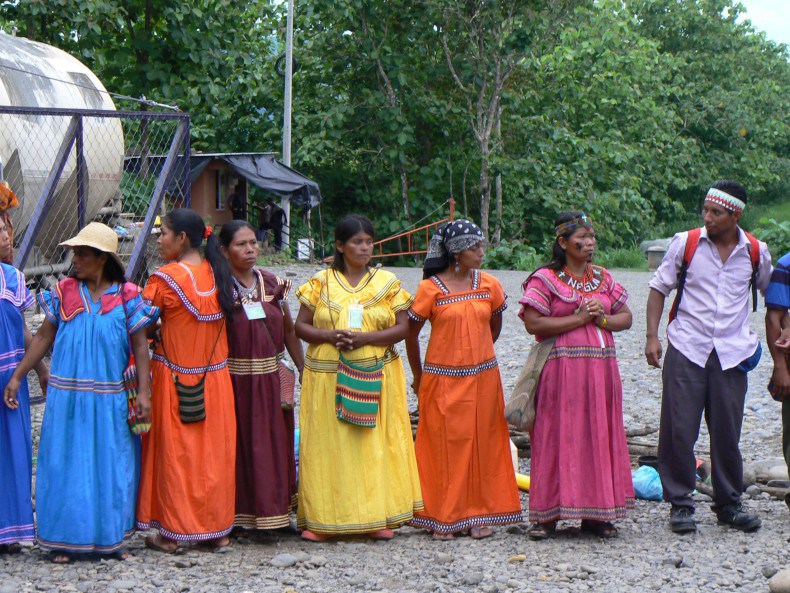
by DGR Colorado Plateau | Aug 5, 2015 | Biodiversity & Habitat Destruction, Colonialism & Conquest, Indigenous Autonomy, Obstruction & Occupation
By Richard Arghiris and Jennifer Kennedy / Intercontinental Cry
June 14, 2015
NGÄBE ISSUE ULTIMATUM TO THE GOVERNMENT OF PANAMA: CANCEL THE PROJECT BY MONDAY
A 30-strong splinter group of Ngäbe from the M10 resistance movement has blocked the entrance to the Barro Blanco hydroelectric dam in western Panama, preventing workers from entering the site. The 15 year struggle of the Tabasará river communities to protect their livelihoods, their culture, and their ancestral heritage now appears to be entering a tense new phase. With negotiations exhausted and the dam 95% complete, M10 has an issued an ultimatum for the government to cancel the project by Monday, June 15, 2015. It is unclear how the government will respond.
“Being Ngäbe-Buglé cultural patrimony,” said Clementina Pérez, part of the group camped at Barro Blanco’s gates. “Our river, our mother earth, our ecology, our existence, we are here to make known to the national and international community that this patrimony belongs to us and to the church of Mama Tata. With the conservation of peace, liberty, justice and unity, liberation and social justice… [we ask] the President of the Republic the cancellation and removal of the dam from our communities, our river and our mother earth, which belong to us as original people of the Americas…”
Funded by European banks – the German Investment Corporation (DEG) and the Dutch Development Bank (FMO) – the dam is set to inundate a string of Ngäbe and campesino communities, all of whom have voiced their objections from the outset. The flood will destroy ancestral petroglyphs, fertile agricultural grounds, and Mama Tata cultural centres, including a unique school where the emerging written script of the Ngäbere language is being developed and disseminated. The dam will significantly impact the river’s marine life, wiping out migratory fish species which many communities – both up and down stream – rely upon for essential protein. None of the Tabasará communities have provided their free, informed and prior consent to the dam, a fact recently confirmed by the FMO’s own independent complaints mechanism (ICM).
“Lenders should have sought greater clarity on whether there was consent to the project from the appropriate indigenous authorities prior to project approval,” said an ICM report, published on May 29, 2015. “[The plan] contains no provision on land acquisition and resettlement and nothing on biodiversity and natural resources management. Neither does it contain any reference to issues related to cultural heritage…”
The report is the latest in a series of professional analyses that pour a thick layer of scorn over the dam project’s owner, Generadora del Istmo (GENISA). Demonstrably unlawful, GENISA has been condemned by numerous independent investigators, the United Nations, several international NGOs, and Panama’s own environmental agency, ANAM, who found a raft of flaws and short-comings in their environmental impact assessment.
But despite failing their own due diligence, the banks appear to have shrugged off the ICM report with an insipid call for “constructive dialogue” and “a solution for a way forward.” In February this year, the FMO chose to threaten the government of Panama after building work was temporarily suspended on the recommendation of ANAM. Writing to the Vice President, the FMO warned that the suspension “May weigh upon future investment decisions, and harm the flow of long-term investments into Panama.”
The government seems to have taken this threat to heart. Panama’s president, Juan Carlos Varela, who was elected to office in 2014, flip-flopped on Barro Blanco before finally falling in line. Last week, while proffering flimsy reassurances about having found a human rights solution, his government left the negotiating table and signaled an end to the suspension of works. M10 claims the work never stopped and has been continuing clandestinely. They are now mobilizing for action.

Clementina Perez (Photo: Oscar Sogandares)
“If this situation is not resolved,” said Clementina Pérez, “We will go to the Panamerican highway to ask together, at a national level, the cancellation of Barro Blanco…”
Rising with stark grey walls above the denuded banks of the Tabasará, Barro Blanco has become a symbol of the previous administration, its fundamental violence and contempt for the rule of law. The former President Ricardo Martinelli – now on the run in the United States and facing a corruption probe back home – provoked no less than four major uprisings as he grasped for land and resources in Panama’s indigenous territories. Heavy-handed repression resulted in the deaths of several protesters and bystanders, including an unarmed teenage boy who was shot in the face by police. Barro Blanco is the visible legacy of a proudly thuggish President who serially abused Panama’s Indigenous Peoples and plundered the country at will. Thus far, Varela has been keen to strike a more decent and humane tone. How he now handles the crisis evolving on the banks of the Tabasará River will be a demonstration of his sincerity, or lack of.
From Intercontinental Cry: https://intercontinentalcry.org/ngabe-block-entry-to-barro-blanco-hydro-dam-panama-28186/







